Table of contents
- What you should know about engines Basics of engine types
- Single cylinder
- Two cylinder V, 90 degrees
- Two cylinder V, 45 degrees
- Two-cylinder series
- Two-cylinder boxer
- Three-cylinder series
- Four-cylinder series
- Four-cylinder V

counselor
workshop
Motorcycle engines: all types
What you should know about engines
Basics of engine types
Depending on how many cylinders an engine has and how they are arranged in relation to one another, there are different characteristics with their own advantages and disadvantages. 2Rader explains what to look out for.
Manuel Fuchs
02/07/2011
Depending on how many cylinders an engine has and how they are arranged in relation to one another
there are different characteristics with their own advantages and disadvantages.
Motors at a glance:
Single cylinder
The perfect engine for modern, as light as possible machines (e.g. enduros) between 125 and 650 cm³. Typical representative: BMW F 650.
Two cylinder V, 45 degrees
Without a lot of effort, only modest performance can be tickled from this design. The very rustic character and the great sound make up for it – so ideal for cruisers and choppers.
Two cylinder V, 90 degrees
If you like to be sporty on the road, but don’t want to do without a powerful engine, this is the right place for you.
Two-cylinder series
Simple and inexpensive to produce, relatively easy to maintain, and compact and
powerful – the two-cylinder in-line engine goes well with the dynamic middle class.
Two-cylinder boxers
The boxer engine requires a lot of space, and it is complex and expensive to produce because many parts are used twice.
Three-cylinder series
Individuality, performance, smoothness and above all the great sound (Porsche sends its regards) – the three-cylinder is the insider tip for technology gourmets.
Four-cylinder series
It usually doesn’t look particularly good, and at first glance doesn’t offer the most exciting technical solutions either, but it is still the first choice for modern athletes.
Four-cylinder V
Fans of sophisticated mechanical engineering still have theirs on the V-four-cylinder
Pleasure. The concept is rather unsuitable for technology realists and frugal natures.
Single cylinder
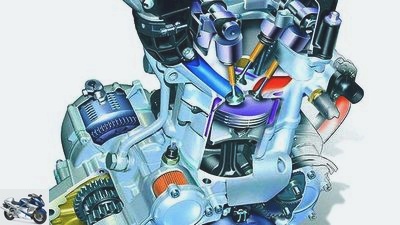
Single cylinder.
The most modern form of the original engine has four-valve technology, two overhead camshafts and injection. Liquid cooling provides thermal safety and reduces noise development. Ease of rotation, compact dimensions, low mass and ease of maintenance speak in favor of this design; Limited performance make the single cylinder particularly interesting for off-road machines, fun bikes, light all-rounders and entry-level motorcycles.
The perfect engine for modern, as light as possible machines (e.g. enduros) between 125 and 650 cm³. Typical representative: BMW F 650.
Two cylinder V, 90 degrees
With a transverse crankshaft installed, it is significantly narrower than a four-cylinder in-line engine, and it is lighter anyway. A 90 degree cylinder angle (in the picture the engine of a Ducati 1098) results in a much smoother running than a comparable in-line two-cylinder. With water cooling, it is highly resilient and powerful enough to also survive in racing. The disadvantages are the high manufacturing cost, because many parts are required twice, and the poor ease of maintenance.
If you like to be sporty on the road, but don’t want to do without a powerful engine, this is the right place for you.
Two cylinder V, 45 degrees
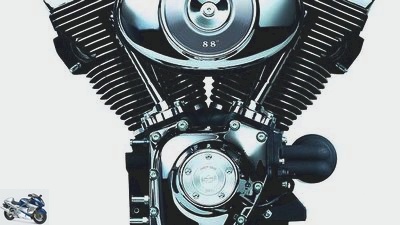
Two cylinder V, 45 degrees.
The 45 degree cylinder angle of the Harley-Davidson engine, probably the most famous representative of this class, is technically absurd. In this arrangement (technically “superfluous”) No longer absorb inertia forces with counterweights on the crankshaft – the engine shakes and vibrates over the entire speed range. But that’s probably exactly what is wanted. The advantages, which are indisputable even from a technical point of view, are the compact design and the relatively high ease of maintenance.
Without a lot of effort, only modest performance can be tickled from this design. The very rustic character and the great sound make up for it – so ideal for cruisers and choppers.
Two-cylinder series
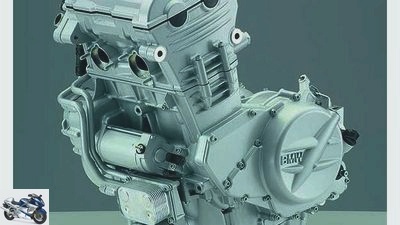
Two-cylinder series.
When the two pistons move up and down synchronously in their cylinders, one speaks of a parallel twin. Advantage: good power development in the lower and middle speed range. At higher speeds, however, the engine tends to generate strong vibrations, which can be reduced with compensation systems (in the picture: BMW F 800). If the pistons run in opposite directions, it is called the engine “Counter-runner”. It offers smoother running, but less pulling power.
Simple and inexpensive to produce, relatively easy to maintain, compact and powerful – the two-cylinder in-line engine fits in well with the dynamic middle class.
Two-cylinder boxer
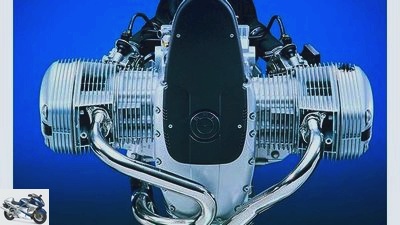
Two-cylinder boxer.
It doesn’t get any flatter, in English the boxer is called “flat engine” (Flat motor). The design makes it possible to give the machine a very low center of gravity, which in turn increases its handiness. The protruding cylinders are very easily accessible for maintenance and repair work. There are no thermal problems, even with a large displacement and relatively high output, air cooling is sufficient for the two-cylinder boxer. Its concentricity is excellent, the overturning moment at very low speeds is only noticeable as a harmless shaking.
The crankshaft fits directly to the gearbox, making a primary drive unnecessary. The boxer engine requires a lot of space, and it is complex and expensive to produce because many parts are used twice.
Three-cylinder series
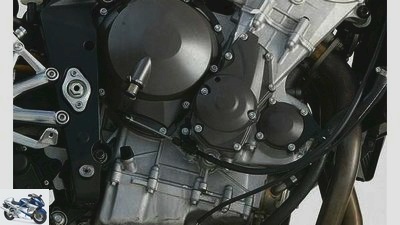
Three-cylinder series.
An often underestimated design; The triple combines some of the advantages of two- and four-cylinder engines. Its smoothness and performance are better than those of the twin. Its manufacturing costs, dimensions and weight are below the values of the four-pack. In the early three-cylinder phase (mid-1970s, Yamaha XS 750), the image was an obstacle to sales, later the honest packaging and the big sister of the BMW K 75 (1985) ruined the success. The Triumph three-cylinder show today the potential of the triple.
Individuality, performance, smoothness and above all the great sound (Porsche sends its regards) – the three-cylinder is the insider tip for technology gourmets.
Four-cylinder series
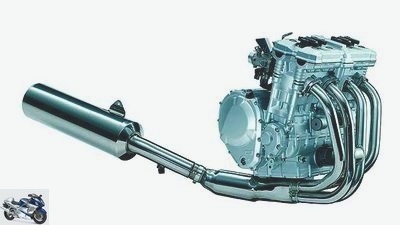
Four-cylinder series.
When it comes to horsepower, the path to series production motorcycles is via the four-cylinder in-line engine. It offers the best prerequisites: Short (gas) paths and few moving components, because only one cylinder block is required with it. Smooth running and speed stability are among its strengths. Modern materials allow many components to be designed in a filigree yet stable manner. That puts its main disadvantages into perspective: overall width and mass. The insulating and heat-dissipating water jacket is a must when looking for performance.
It usually doesn’t look particularly good, and at first glance doesn’t offer the most exciting technical solutions either, but it is still the first choice for modern athletes.
Four-cylinder V
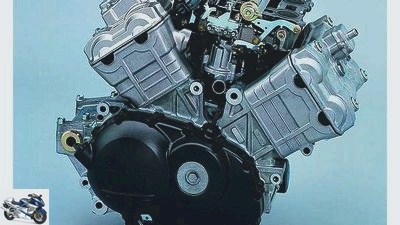
Four-cylinder V.
The smooth running of a modern V-engine in connection with small, very high-speed individual displacement – this technically attractive combination offers the V-four-cylinder. In addition, the engine is not as wide as a four-cylinder in-line engine. Many years ago, Honda relied on the V-Quad for its top models on a grand scale, today it only drives the VFR 800, the VFR 1200 F, as well as the Aprilia RSV4 and Tuono. With all other top performers, Honda relies on the in-line engine again. The V4 is a technical delight, but it is very complex and expensive to manufacture and maintain.
Fans of the well-kept mechanical engineering still enjoy the V-four-cylinder. The concept is rather unsuitable for technology realists and frugal natures.
Related articles
-
The little ABC of motorcycle types, part two, E ?? H
Harley-Davidson motorcycles The little ABC of motorcycle types, part two, E ?? H The little ABC of motorcycle types, part two, E ?? H VSOP 850 FLHRSI…
-
Kawasaki 15th pictures archive 1/15 The frame is crucial for the driving behavior. archive 2/15 When designing the main frame, the following parameters,…
-
The small ABC of motorcycle types, part 3 K ?? Y
Yamaha motorcycles The small ABC of motorcycle types, part 3 K ?? Y The small ABC of motorcycle types, part 3 K ?? Y No X in front of a U Why are Z, X…
-
The small ABC of motorcycle types, part 1 A ?? D.
Buell motorcycles The small ABC of motorcycle types, part 1 A ?? D. The small ABC of motorcycle types, part 1 A ?? D. ETV 1000 XB9R S4R Manufacturers…
-
Kawasaki 12th pictures BMW 1/12 Norbert Klauer (58), Head of Powertrain Development at BMW Motorrad, on the possibilities and difficulties of the…
-
Tips for mechanics: Maintenance of motorcycle cooling systems
Ralf Petersen 15th pictures Ralf Petersen 1/15 We explain how the maintenance of a cooling system works. Ralf Petersen 2/15 This is needed for…
-
Tips and tricks for motorcycle care
Rolf Henniges counselor technology & future Tips and tricks for motorcycle care Tips and tricks for motorcycle care Breaking in a new engine is…
-
Eleven motorcycle tire warmers in a comparison test
mps photo studio 48 pictures mps photo studio 1/48 Eleven motorcycle tire warmers in a comparison test. Yvonne Hertler 2/48 The test bikes were donated…
-
10 years of progress in motorcycle series production
Rossen Gargolov 36 pictures r-photography.info 1/36 r-photography.info 2/36 In a mirror of the times: the BMW R 1200 GS, old on the left and new on the…
-
Honda NC 700 S in the test: the entry-level motorcycle from Honda
Artist 12th pictures Honda 1/12 Honda NC 700 S – The naked bike is powered by an in-line two-cylinder engine of 670 cubic meters. Honda 2/12 Honda NC 700…